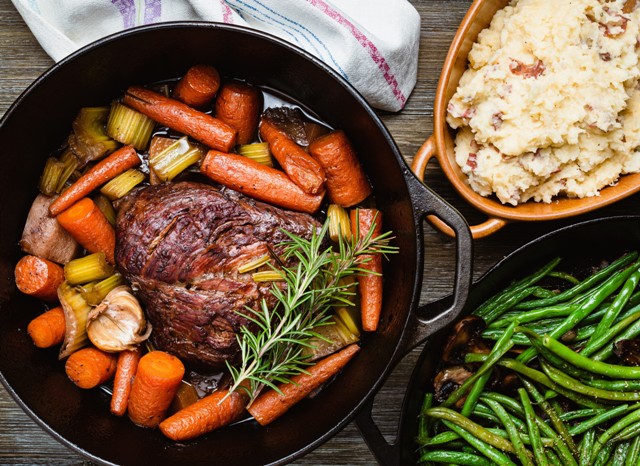Everybody loves good food, but people know it doesn’t appear out of thin air. It takes time and effort to come up with a mouthwatering meal. Not only that, but you also need the right equipment to maximize your food preparation. But what if I told you there’s an appliance that offers efficiency and versatility in one? This is where a combi oven enters the picture.

Are you a passionate learner who’s new to preparing your own food? Or are you a seasoned cook who wants to add new equipment to their arsenal? Then, stumbling upon this article isn’t an accident. Spice up your food game by knowing what a combi is and why it should be in your kitchen the next time you cook.
What is a Combi Oven?
A combi oven, short for combination oven, is a multifunctional cooking appliance that combines three methods of cooking in one unit: convection cooking, steam cooking, and a combination of both. This versatility allows chefs to perform a variety of cooking techniques, from roasting and baking to steaming and poaching, all in a single piece of equipment.
Combi ovens have gained widespread popularity across the globe, particularly in regions with thriving culinary scenes and a demand for versatile cooking equipment. From Michelin-starred restaurants in Europe to bustling food trucks in North America, these ovens have become a staple in professional kitchens.
In Asia where diverse culinary traditions and flavors converge, a combi oven Malaysia proves to be the next big thing. The ability to seamlessly transition between dry and moist heat cooking methods makes them well-suited for preparing a wide range of dishes, from crispy-skinned roasted meats to delicate steamed dumplings.
Benefits of a Combi Oven
Combi ovens operate using sophisticated technology to control temperature, humidity, and airflow, allowing for precise and consistent cooking results. These ovens typically have programmable settings for different cooking modes, making it easy to select the appropriate settings for a particular dish. Here’s an overview of their benefits:
Space and Energy Efficiency
One of the primary advantages of a combi oven is its space-saving design. Combining multiple cooking functions into a single unit eliminates the need for separate ovens and steamers, making it an ideal choice for kitchens with limited space.

Versatility and Consistency
With the ability to switch between dry heat, moist heat, and combination cooking modes, a combi oven offers unparalleled versatility. Whether you’re baking, roasting, steaming, or regenerating foods, this appliance ensures consistent results across a wide range of culinary applications.
Precise Temperature and Humidity Control
Advanced combi ovens feature precise temperature and humidity control systems, allowing chefs to fine-tune the cooking environment to achieve the desired results. This level of control is particularly valuable for intricate dishes or specialized cooking techniques.
Time and Labor Savings
A combi oven streamlines kitchen operations and reduces the need for constant monitoring and transferring of foods between different equipment. This efficiency translates into time and labor savings for both household and busy commercial kitchens.
Ingredient Quality Preservation
The moist heat cooking capabilities of a combi oven help preserve the natural flavors, colors, and nutrients of ingredients. This is especially beneficial for delicate items like fish, vegetables, and certain baked goods, ensuring their quality and freshness are maintained throughout the cooking process.
If you’re serious about cooking, whether professionally or at home, a combi oven is a valuable tool that can enhance your cooking capabilities.
Factors to Consider When Choosing a Combi Oven
When selecting a combi oven for your household or commercial kitchen or professional culinary establishment, several factors should be taken into consideration:
Capacity and Size
Combi ovens come in various sizes, ranging from compact countertop models to large floor-standing units. Consider the volume of food you need to prepare and the available space in your kitchen to determine the appropriate capacity and size.
Energy Efficiency
Look for models that are energy-efficient, as combi ovens can consume significant amounts of electricity and water. Energy-saving features such as insulation and advanced controls can help reduce operating costs over time.
Programmability and User-Friendliness
Many modern combi ovens offer programmable controls and pre-set cooking programs, making it easier for users to achieve consistent results with minimal effort. User-friendly interfaces and intuitive controls can also simplify the learning curve for kitchen staff.
Investing in a reputable brand with a strong track record in the commercial kitchen equipment industry can ensure quality, durability, and reliable customer support. Additionally, consider the availability of service and maintenance support in your area.
Inner Cavity
The inner cavity material of a combi oven is crucial for hygiene and durability. These ovens use SUS304 stainless steel, known for its superior corrosion resistance and ease of cleaning. This material can withstand the demands of a busy kitchen, remaining free from rust and stains. Its smooth, non-porous surface prevents food and grease buildup, ensuring high sanitation standards during any cooking session.
Safety Features
Safety features are crucial when choosing a combi oven. These models include an auto-lock function and triple-layer glass doors. The auto-lock ensures the oven door stays securely closed during operation, preventing accidental burns.
The triple-layer glass also provides excellent insulation, keeping the exterior cool and enhancing energy efficiency by minimising heat loss. These features prioritise safety and efficiency, offering peace of mind and a safer working environment for kitchen staff.
Conclusion
A combi oven’s ability to seamlessly combine dry and moist heat cooking methods, coupled with precise temperature and humidity control, opens a world of possibilities for professional chefs and home cooks alike. Elevate your dishes to new heights and redefine the dining experience for your guests or loved ones.

















